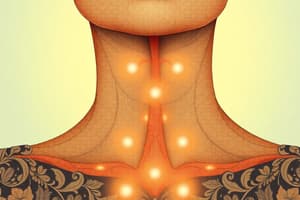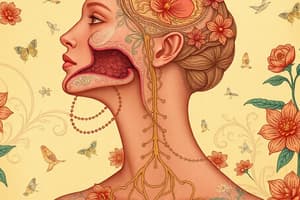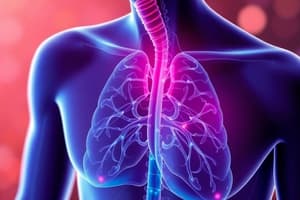Podcast
Questions and Answers
What is one of the primary functions of the thyroid gland?
What is one of the primary functions of the thyroid gland?
- Secrete thyroid hormones (correct)
- Produce insulin
- Regulate blood pressure
- Store calcium
What is a potential outcome of thyroid dysfunction during fetal life?
What is a potential outcome of thyroid dysfunction during fetal life?
- Accelerated growth in stature
- Severe mental retardation (correct)
- Increased physical endurance
- Enhanced cognitive abilities
What does the absence or hypofunction of the thyroid gland during neonatal life lead to?
What does the absence or hypofunction of the thyroid gland during neonatal life lead to?
- Normal cognitive development
- Improved metabolic efficiency
- Dwarfism and mental impairment (correct)
- Increased height and weight
Which of the following symptoms are most commonly associated with hyperthyroidism?
Which of the following symptoms are most commonly associated with hyperthyroidism?
How does the secretion of thyroid-stimulating hormone (TSH) primarily get regulated?
How does the secretion of thyroid-stimulating hormone (TSH) primarily get regulated?
What emotional and physiological effects can result from adult hypothyroidism?
What emotional and physiological effects can result from adult hypothyroidism?
What is the primary role of thyroid peroxidase in thyroid hormone synthesis?
What is the primary role of thyroid peroxidase in thyroid hormone synthesis?
What is the significance of the thyroglobulin reservoir in colloid?
What is the significance of the thyroglobulin reservoir in colloid?
How does thymocyte internalize colloid when thyroid hormone secretion is required?
How does thymocyte internalize colloid when thyroid hormone secretion is required?
Which compound is a product of the condensation reaction between DIT and MIT?
Which compound is a product of the condensation reaction between DIT and MIT?
What is the average daily secretion of T4 by the human thyroid?
What is the average daily secretion of T4 by the human thyroid?
What percentage of circulating T4 is typically converted to T3 in adult humans?
What percentage of circulating T4 is typically converted to T3 in adult humans?
What are the primary secretions of the adrenal medulla?
What are the primary secretions of the adrenal medulla?
What is the primary role of mineralocorticoids produced by the adrenal cortex?
What is the primary role of mineralocorticoids produced by the adrenal cortex?
Which zone of the adrenal cortex is primarily responsible for the biosynthesis of aldosterone?
Which zone of the adrenal cortex is primarily responsible for the biosynthesis of aldosterone?
Which of the following hormones is NOT synthesized in the adrenal cortex?
Which of the following hormones is NOT synthesized in the adrenal cortex?
What is the role of the zona fasciculate in the adrenal cortex?
What is the role of the zona fasciculate in the adrenal cortex?
What process leads to the formation of epinephrine from norepinephrine?
What process leads to the formation of epinephrine from norepinephrine?
Which substance is primarily involved in the synthesis of norepinephrine?
Which substance is primarily involved in the synthesis of norepinephrine?
Which pathway mediates the increase in heart contraction force and rate caused by norepinephrine and epinephrine?
Which pathway mediates the increase in heart contraction force and rate caused by norepinephrine and epinephrine?
What metabolic effect do norepinephrine and epinephrine promote in liver and skeletal muscle?
What metabolic effect do norepinephrine and epinephrine promote in liver and skeletal muscle?
Which type of adrenergic receptors are responsible for mediating the vasoconstriction effect of norepinephrine?
Which type of adrenergic receptors are responsible for mediating the vasoconstriction effect of norepinephrine?
How does dopamine likely cause vasoconstriction in the body?
How does dopamine likely cause vasoconstriction in the body?
Where is dopamine primarily synthesized in the body?
Where is dopamine primarily synthesized in the body?
Which enzyme is responsible for the formation of free cholesterol in lipid droplets?
Which enzyme is responsible for the formation of free cholesterol in lipid droplets?
Which of the following correctly describes the pathway of cholesterol transport in steroid biosynthesis?
Which of the following correctly describes the pathway of cholesterol transport in steroid biosynthesis?
How is the secretion of adrenal androgens primarily controlled in the body?
How is the secretion of adrenal androgens primarily controlled in the body?
What effect do glucocorticoids have on peripheral tissues in relation to insulin?
What effect do glucocorticoids have on peripheral tissues in relation to insulin?
What is the immediate effect of glucose infusion in patients with untreated adrenal insufficiency?
What is the immediate effect of glucose infusion in patients with untreated adrenal insufficiency?
What physiological imbalance is associated with adrenal insufficiency due to the failure to excrete water load?
What physiological imbalance is associated with adrenal insufficiency due to the failure to excrete water load?
What is a characteristic feature of the fat distribution in patients with Cushing syndrome?
What is a characteristic feature of the fat distribution in patients with Cushing syndrome?
Which physical change is NOT typically associated with Cushing syndrome?
Which physical change is NOT typically associated with Cushing syndrome?
What is the primary effect of aldosterone on sodium levels in the extracellular fluid (ECF)?
What is the primary effect of aldosterone on sodium levels in the extracellular fluid (ECF)?
What role does aldosterone play in modulating urine acidity?
What role does aldosterone play in modulating urine acidity?
Flashcards
Thyroid gland function
Thyroid gland function
Maintaining optimal tissue metabolism by secreting thyroid hormones.
Thyroid hormone effect on cells
Thyroid hormone effect on cells
Stimulates oxygen use in most body cells, influencing metabolism.
Thyroid hormone's impact on body
Thyroid hormone's impact on body
Influences body mass & mental function through lipid & carbohydrate metabolism.
Early thyroid dysfunction impact
Early thyroid dysfunction impact
Signup and view all the flashcards
Thyroid necessity
Thyroid necessity
Signup and view all the flashcards
Hypothyroidism
Hypothyroidism
Signup and view all the flashcards
Hyperthyroidism
Hyperthyroidism
Signup and view all the flashcards
Thyroid-stimulating hormone (TSH)
Thyroid-stimulating hormone (TSH)
Signup and view all the flashcards
Negative feedback control in thyroid hormone production
Negative feedback control in thyroid hormone production
Signup and view all the flashcards
Calcitonin
Calcitonin
Signup and view all the flashcards
Thyroglobulin
Thyroglobulin
Signup and view all the flashcards
Thyroid Peroxidase
Thyroid Peroxidase
Signup and view all the flashcards
Colloid
Colloid
Signup and view all the flashcards
How long can humans go without iodine?
How long can humans go without iodine?
Signup and view all the flashcards
How are thyroid hormones released?
How are thyroid hormones released?
Signup and view all the flashcards
MIT
MIT
Signup and view all the flashcards
DIT
DIT
Signup and view all the flashcards
T4 formation
T4 formation
Signup and view all the flashcards
T3 formation
T3 formation
Signup and view all the flashcards
T4 vs. T3
T4 vs. T3
Signup and view all the flashcards
T4 and T3 conversion
T4 and T3 conversion
Signup and view all the flashcards
T3's role in thyroid function
T3's role in thyroid function
Signup and view all the flashcards
TSH regulation
TSH regulation
Signup and view all the flashcards
Negative feedback in thyroid control
Negative feedback in thyroid control
Signup and view all the flashcards
T4's role in TSH regulation
T4's role in TSH regulation
Signup and view all the flashcards
Adrenal Medulla
Adrenal Medulla
Signup and view all the flashcards
Adrenal Cortex
Adrenal Cortex
Signup and view all the flashcards
Glucocorticoids
Glucocorticoids
Signup and view all the flashcards
Mineralocorticoids
Mineralocorticoids
Signup and view all the flashcards
Adrenal Androgens
Adrenal Androgens
Signup and view all the flashcards
Adrenal Medulla Cell Types
Adrenal Medulla Cell Types
Signup and view all the flashcards
Adrenal Cortex Zones
Adrenal Cortex Zones
Signup and view all the flashcards
Zona Glomerulosa Function
Zona Glomerulosa Function
Signup and view all the flashcards
Cortisol Production Location
Cortisol Production Location
Signup and view all the flashcards
Aldosterone Biosynthesis
Aldosterone Biosynthesis
Signup and view all the flashcards
Catecholamine Synthesis
Catecholamine Synthesis
Signup and view all the flashcards
Catecholamine Conjugation
Catecholamine Conjugation
Signup and view all the flashcards
Catecholamine Half-Life
Catecholamine Half-Life
Signup and view all the flashcards
Adrenal Medulla's Role
Adrenal Medulla's Role
Signup and view all the flashcards
Catecholamines: Function?
Catecholamines: Function?
Signup and view all the flashcards
Norepinephrine and epinephrine's metabolic effects
Norepinephrine and epinephrine's metabolic effects
Signup and view all the flashcards
α- and β-adrenergic receptors
α- and β-adrenergic receptors
Signup and view all the flashcards
Catecholamines and insulin/glucagon secretion
Catecholamines and insulin/glucagon secretion
Signup and view all the flashcards
Catecholamines' effect on heart rate and contraction
Catecholamines' effect on heart rate and contraction
Signup and view all the flashcards
Norepinephrine and epinephrine's opposing vascular effects
Norepinephrine and epinephrine's opposing vascular effects
Signup and view all the flashcards
Dopamine's function in circulation
Dopamine's function in circulation
Signup and view all the flashcards
Dopamine's effect on kidneys
Dopamine's effect on kidneys
Signup and view all the flashcards
Dopamine's vasoconstrictive action
Dopamine's vasoconstrictive action
Signup and view all the flashcards
Dopamine's effect on heart
Dopamine's effect on heart
Signup and view all the flashcards
Dopamine's production location
Dopamine's production location
Signup and view all the flashcards
Cholesterol's Role in Steroid Synthesis
Cholesterol's Role in Steroid Synthesis
Signup and view all the flashcards
Pregnenolone: The First Step
Pregnenolone: The First Step
Signup and view all the flashcards
ACTH's Role
ACTH's Role
Signup and view all the flashcards
Mitochondria: The Steroid Factory
Mitochondria: The Steroid Factory
Signup and view all the flashcards
Smooth ER: Steroid Refinement
Smooth ER: Steroid Refinement
Signup and view all the flashcards
Androgens & Masculinization
Androgens & Masculinization
Signup and view all the flashcards
Androgen Secretion Control
Androgen Secretion Control
Signup and view all the flashcards
Testosterone: The Dominant Androgen
Testosterone: The Dominant Androgen
Signup and view all the flashcards
Androgen Excess in Adults
Androgen Excess in Adults
Signup and view all the flashcards
ACTH & Androgen Production
ACTH & Androgen Production
Signup and view all the flashcards
What do glucocorticoids do to glucose levels?
What do glucocorticoids do to glucose levels?
Signup and view all the flashcards
How do glucocorticoids affect insulin?
How do glucocorticoids affect insulin?
Signup and view all the flashcards
What organs benefit from glucocorticoids' effects on glucose?
What organs benefit from glucocorticoids' effects on glucose?
Signup and view all the flashcards
What happens to lipids in diabetics treated with glucocorticoids?
What happens to lipids in diabetics treated with glucocorticoids?
Signup and view all the flashcards
What is the effect of glucocorticoids on protein?
What is the effect of glucocorticoids on protein?
Signup and view all the flashcards
What is a key feature of adrenal insufficiency?
What is a key feature of adrenal insufficiency?
Signup and view all the flashcards
What uniquely addresses the water load issue in adrenal insufficiency?
What uniquely addresses the water load issue in adrenal insufficiency?
Signup and view all the flashcards
What can happen to patients with untreated adrenal insufficiency during glucose infusion?
What can happen to patients with untreated adrenal insufficiency during glucose infusion?
Signup and view all the flashcards
What's the term for the reaction to glucose in untreated adrenal insufficiency?
What's the term for the reaction to glucose in untreated adrenal insufficiency?
Signup and view all the flashcards
Why is glucose infusion risky for untreated adrenal insufficiency?
Why is glucose infusion risky for untreated adrenal insufficiency?
Signup and view all the flashcards
Cushing Syndrome
Cushing Syndrome
Signup and view all the flashcards
Protein Catabolism in Cushing Syndrome
Protein Catabolism in Cushing Syndrome
Signup and view all the flashcards
Fat Redistribution in Cushing Syndrome
Fat Redistribution in Cushing Syndrome
Signup and view all the flashcards
Adrenal Androgens in Cushing Syndrome
Adrenal Androgens in Cushing Syndrome
Signup and view all the flashcards
What causes the 'buffalo hump' in Cushing Syndrome?
What causes the 'buffalo hump' in Cushing Syndrome?
Signup and view all the flashcards
Mineralocorticoids' Effect on Sodium
Mineralocorticoids' Effect on Sodium
Signup and view all the flashcards
ECF Expansion
ECF Expansion
Signup and view all the flashcards
Sodium-Potassium Exchange
Sodium-Potassium Exchange
Signup and view all the flashcards
Aldosterone's Impact on Urine
Aldosterone's Impact on Urine
Signup and view all the flashcards
Mineralocorticoid Effect on ECF Volume?
Mineralocorticoid Effect on ECF Volume?
Signup and view all the flashcards
Study Notes
Thyroid Gland Function
- Endocrine gland, one of the larger ones in the body.
- Two primary functions relating to thyroid hormone secretion.
- Maintains optimal tissue metabolism.
- Stimulates oxygen consumption in most body cells.
- Regulates lipid and carbohydrate metabolism.
- Influences body mass and mental function.
Thyroid Dysfunction Consequences
- Consequences vary based on the life stage of dysfunction.
- Absence or underactivity (hypofunction) during fetal/neonatal periods can lead to profound mental retardation and dwarfism.
- Thyroid is not crucial for survival in adulthood.
Studying That Suits You
Use AI to generate personalized quizzes and flashcards to suit your learning preferences.
Description
Test your knowledge on the functions and consequences of thyroid gland activities. This quiz covers the thyroid's role in metabolism, oxygen consumption, and the effects of dysfunction at various life stages. Learn about both hypothyroidism and hyperthyroidism in depth.




